Lin Xu
Joy
Aeolus: A Multi-structural Flight Delay Dataset
Oct 30, 2025Abstract:We introduce Aeolus, a large-scale Multi-modal Flight Delay Dataset designed to advance research on flight delay prediction and support the development of foundation models for tabular data. Existing datasets in this domain are typically limited to flat tabular structures and fail to capture the spatiotemporal dynamics inherent in delay propagation. Aeolus addresses this limitation by providing three aligned modalities: (i) a tabular dataset with rich operational, meteorological, and airportlevel features for over 50 million flights; (ii) a flight chain module that models delay propagation along sequential flight legs, capturing upstream and downstream dependencies; and (iii) a flight network graph that encodes shared aircraft, crew, and airport resource connections, enabling cross-flight relational reasoning. The dataset is carefully constructed with temporal splits, comprehensive features, and strict leakage prevention to support realistic and reproducible machine learning evaluation. Aeolus supports a broad range of tasks, including regression, classification, temporal structure modeling, and graph learning, serving as a unified benchmark across tabular, sequential, and graph modalities. We release baseline experiments and preprocessing tools to facilitate adoption. Aeolus fills a key gap for both domain-specific modeling and general-purpose structured data research.Our source code and data can be accessed at https://github.com/Flnny/Delay-data
CLAP: Coreference-Linked Augmentation for Passage Retrieval
Aug 09, 2025Abstract:Large Language Model (LLM)-based passage expansion has shown promise for enhancing first-stage retrieval, but often underperforms with dense retrievers due to semantic drift and misalignment with their pretrained semantic space. Beyond this, only a portion of a passage is typically relevant to a query, while the rest introduces noise--an issue compounded by chunking techniques that break coreference continuity. We propose Coreference-Linked Augmentation for Passage Retrieval (CLAP), a lightweight LLM-based expansion framework that segments passages into coherent chunks, resolves coreference chains, and generates localized pseudo-queries aligned with dense retriever representations. A simple fusion of global topical signals and fine-grained subtopic signals achieves robust performance across domains. CLAP yields consistent gains even as retriever strength increases, enabling dense retrievers to match or surpass second-stage rankers such as BM25 + MonoT5-3B, with up to 20.68% absolute nDCG@10 improvement. These improvements are especially notable in out-of-domain settings, where conventional LLM-based expansion methods relying on domain knowledge often falter. CLAP instead adopts a logic-centric pipeline that enables robust, domain-agnostic generalization.
Kimi K2: Open Agentic Intelligence
Jul 28, 2025Abstract:We introduce Kimi K2, a Mixture-of-Experts (MoE) large language model with 32 billion activated parameters and 1 trillion total parameters. We propose the MuonClip optimizer, which improves upon Muon with a novel QK-clip technique to address training instability while enjoying the advanced token efficiency of Muon. Based on MuonClip, K2 was pre-trained on 15.5 trillion tokens with zero loss spike. During post-training, K2 undergoes a multi-stage post-training process, highlighted by a large-scale agentic data synthesis pipeline and a joint reinforcement learning (RL) stage, where the model improves its capabilities through interactions with real and synthetic environments. Kimi K2 achieves state-of-the-art performance among open-source non-thinking models, with strengths in agentic capabilities. Notably, K2 obtains 66.1 on Tau2-Bench, 76.5 on ACEBench (En), 65.8 on SWE-Bench Verified, and 47.3 on SWE-Bench Multilingual -- surpassing most open and closed-sourced baselines in non-thinking settings. It also exhibits strong capabilities in coding, mathematics, and reasoning tasks, with a score of 53.7 on LiveCodeBench v6, 49.5 on AIME 2025, 75.1 on GPQA-Diamond, and 27.1 on OJBench, all without extended thinking. These results position Kimi K2 as one of the most capable open-source large language models to date, particularly in software engineering and agentic tasks. We release our base and post-trained model checkpoints to facilitate future research and applications of agentic intelligence.
ALPHAGMUT: A Rationale-Guided Alpha Shape Graph Neural Network to Evaluate Mutation Effects
Jun 13, 2024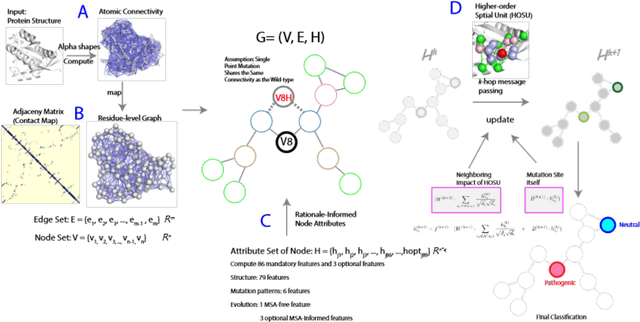



Abstract:In silico methods evaluating the mutation effects of missense mutations are providing an important approach for understanding mutations in personal genomes and identifying disease-relevant biomarkers. However, existing methods, including deep learning methods, heavily rely on sequence-aware information, and do not fully leverage the potential of available 3D structural information. In addition, these methods may exhibit an inability to predict mutations in domains difficult to formulate sequence-based embeddings. In this study, we introduce a novel rationale-guided graph neural network AlphaGMut to evaluate mutation effects and to distinguish pathogenic mutations from neutral mutations. We compute the alpha shapes of protein structures to obtain atomic-resolution edge connectivities and map them to an accurate residue-level graph representation. We then compute structural-, topological-, biophysical-, and sequence properties of the mutation sites, which are assigned as node attributes in the graph. These node attributes could effectively guide the graph neural network to learn the difference between pathogenic and neutral mutations using k-hop message passing with a short training period. We demonstrate that AlphaGMut outperforms state-of-the-art methods, including DeepMind's AlphaMissense, in many performance metrics. In addition, AlphaGMut has the advantage of performing well in alignment-free settings, which provides broader prediction coverage and better generalization compared to current methods requiring deep sequence-aware information.
PLLaVA : Parameter-free LLaVA Extension from Images to Videos for Video Dense Captioning
Apr 29, 2024Abstract:Vision-language pre-training has significantly elevated performance across a wide range of image-language applications. Yet, the pre-training process for video-related tasks demands exceptionally large computational and data resources, which hinders the progress of video-language models. This paper investigates a straight-forward, highly efficient, and resource-light approach to adapting an existing image-language pre-trained model for dense video understanding. Our preliminary experiments reveal that directly fine-tuning pre-trained image-language models with multiple frames as inputs on video datasets leads to performance saturation or even a drop. Our further investigation reveals that it is largely attributed to the bias of learned high-norm visual features. Motivated by this finding, we propose a simple but effective pooling strategy to smooth the feature distribution along the temporal dimension and thus reduce the dominant impacts from the extreme features. The new model is termed Pooling LLaVA, or PLLaVA in short. PLLaVA achieves new state-of-the-art performance on modern benchmark datasets for both video question-answer and captioning tasks. Notably, on the recent popular VideoChatGPT benchmark, PLLaVA achieves a score of 3.48 out of 5 on average of five evaluated dimensions, exceeding the previous SOTA results from GPT4V (IG-VLM) by 9%. On the latest multi-choice benchmark MVBench, PLLaVA achieves 58.1% accuracy on average across 20 sub-tasks, 14.5% higher than GPT4V (IG-VLM). Code is available at https://pllava.github.io/
Chain of Thought Explanation for Dialogue State Tracking
Mar 09, 2024



Abstract:Dialogue state tracking (DST) aims to record user queries and goals during a conversational interaction achieved by maintaining a predefined set of slots and their corresponding values. Current approaches decide slot values opaquely, while humans usually adopt a more deliberate approach by collecting information from relevant dialogue turns and then reasoning the appropriate values. In this work, we focus on the steps needed to figure out slot values by proposing a model named Chain-of-Thought-Explanation (CoTE) for the DST task. CoTE, which is built on the generative DST framework, is designed to create detailed explanations step by step after determining the slot values. This process leads to more accurate and reliable slot values. More-over, to improve the reasoning ability of the CoTE, we further construct more fluent and high-quality explanations with automatic paraphrasing, leading the method CoTE-refined. Experimental results on three widely recognized DST benchmarks-MultiWOZ 2.2, WoZ 2.0, and M2M-demonstrate the remarkable effectiveness of the CoTE. Furthermore, through a meticulous fine-grained analysis, we observe significant benefits of our CoTE on samples characterized by longer dialogue turns, user responses, and reasoning steps.
CET2: Modelling Topic Transitions for Coherent and Engaging Knowledge-Grounded Conversations
Mar 04, 2024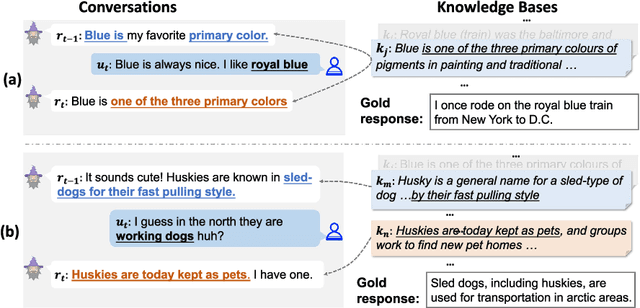
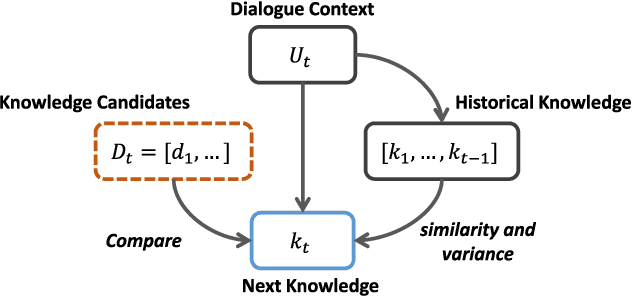
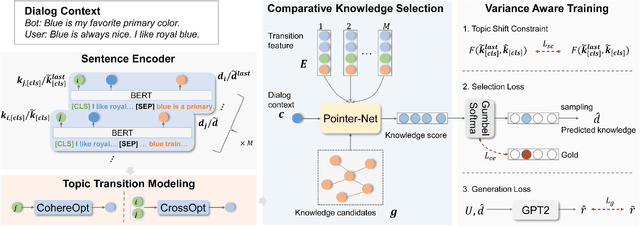

Abstract:Knowledge-grounded dialogue systems aim to generate coherent and engaging responses based on the dialogue contexts and selected external knowledge. Previous knowledge selection methods tend to rely too heavily on the dialogue contexts or over-emphasize the new information in the selected knowledge, resulting in the selection of repetitious or incongruous knowledge and further generating repetitive or incoherent responses, as the generation of the response depends on the chosen knowledge. To address these shortcomings, we introduce a Coherent and Engaging Topic Transition (CET2) framework to model topic transitions for selecting knowledge that is coherent to the context of the conversations while providing adequate knowledge diversity for topic development. Our CET2 framework considers multiple factors for knowledge selection, including valid transition logic from dialogue contexts to the following topics and systematic comparisons between available knowledge candidates. Extensive experiments on two public benchmarks demonstrate the superiority and the better generalization ability of CET2 on knowledge selection. This is due to our well-designed transition features and comparative knowledge selection strategy, which are more transferable to conversations about unseen topics. Analysis of fine-grained knowledge selection accuracy also shows that CET2 can better balance topic entailment (contextual coherence) and development (knowledge diversity) in dialogue than existing approaches.
MAgIC: Investigation of Large Language Model Powered Multi-Agent in Cognition, Adaptability, Rationality and Collaboration
Nov 16, 2023



Abstract:Large Language Models (LLMs) have marked a significant advancement in the field of natural language processing, demonstrating exceptional capabilities in reasoning, tool usage, and memory. As their applications extend into multi-agent environments, a need has arisen for a comprehensive evaluation framework that captures their abilities in reasoning, planning, collaboration, and more. This work introduces a novel benchmarking framework specifically tailored to assess LLMs within multi-agent settings, providing quantitative metrics to evaluate their judgment, reasoning, deception, self-awareness, cooperation, coordination, and rationality. We utilize games such as Chameleon and Undercover, alongside game theory scenarios like Cost Sharing, Multi-player Prisoner's Dilemma, and Public Good, to create diverse testing environments. Our framework is fortified with the Probabilistic Graphical Modeling (PGM) method, enhancing the LLMs' capabilities in navigating complex social and cognitive dimensions. The benchmark evaluates seven multi-agent systems powered by different LLMs, quantitatively highlighting a significant capability gap over threefold between the strongest, GPT-4, and the weakest, Llama-2-70B. It also confirms that our PGM enhancement boosts the inherent abilities of all selected models by 50% on average. Our codes are released here https://github.com/cathyxl/MAgIC.
Hyp-UML: Hyperbolic Image Retrieval with Uncertainty-aware Metric Learning
Oct 22, 2023Abstract:Metric learning plays a critical role in training image retrieval and classification. It is also a key algorithm in representation learning, e.g., for feature learning and its alignment in metric space. Hyperbolic embedding has been recently developed. Compared to the conventional Euclidean embedding in most of the previously developed models, Hyperbolic embedding can be more effective in representing the hierarchical data structure. Second, uncertainty estimation/measurement is a long-lasting challenge in artificial intelligence. Successful uncertainty estimation can improve a machine learning model's performance, robustness, and security. In Hyperbolic space, uncertainty measurement is at least with equivalent, if not more, critical importance. In this paper, we develop a Hyperbolic image embedding with uncertainty-aware metric learning for image retrieval. We call our method Hyp-UML: Hyperbolic Uncertainty-aware Metric Learning. Our contribution are threefold: we propose an image embedding algorithm based on Hyperbolic space, with their corresponding uncertainty value; we propose two types of uncertainty-aware metric learning, for the popular Contrastive learning and conventional margin-based metric learning, respectively. We perform extensive experimental validations to prove that the proposed algorithm can achieve state-of-the-art results among related methods. The comprehensive ablation study validates the effectiveness of each component of the proposed algorithm.
CorefDiffs: Co-referential and Differential Knowledge Flow in Document Grounded Conversations
Oct 05, 2022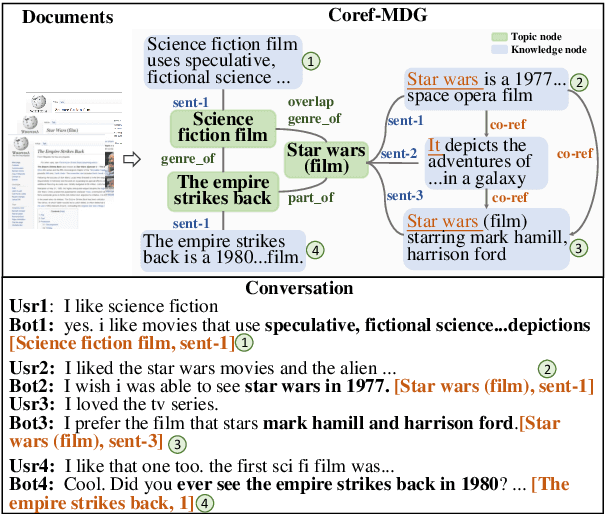


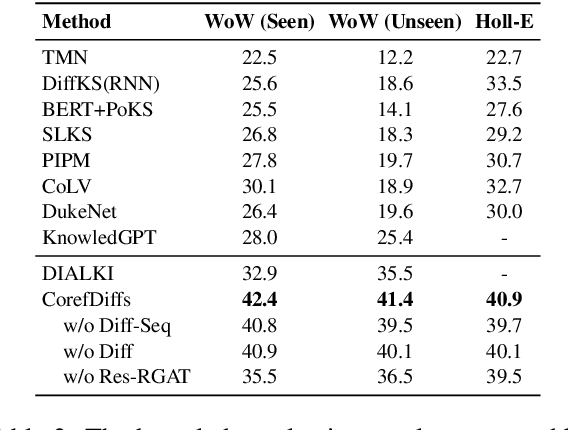
Abstract:Knowledge-grounded dialog systems need to incorporate smooth transitions among knowledge selected for generating responses, to ensure that dialog flows naturally. For document-grounded dialog systems, the inter- and intra-document knowledge relations can be used to model such conversational flows. We develop a novel Multi-Document Co-Referential Graph (Coref-MDG) to effectively capture the inter-document relationships based on commonsense and similarity and the intra-document co-referential structures of knowledge segments within the grounding documents. We propose CorefDiffs, a Co-referential and Differential flow management method, to linearize the static Coref-MDG into conversational sequence logic. CorefDiffs performs knowledge selection by accounting for contextual graph structures and the knowledge difference sequences. CorefDiffs significantly outperforms the state-of-the-art by 9.5\%, 7.4\%, and 8.2\% on three public benchmarks. This demonstrates that the effective modeling of co-reference and knowledge difference for dialog flows are critical for transitions in document-grounded conversation
 Add to Chrome
Add to Chrome Add to Firefox
Add to Firefox Add to Edge
Add to Edge